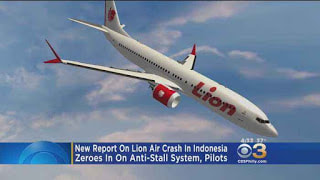 Do you feel safe when you board an airplane for a flight? Typically we do, as we should because air travel is much safer than driving. Well, safer per mile (kilometer), but airplanes are much faster than cars, so per minute the difference is less impressive. And occasionally we get disturbing news like the two crashes of 737 MAX 8 aircraft, one of Boeing’s latest models, with a technical problem being the reason for the crash. We need the speed and convenience of air travel, for a reasonably priced ticket, but we also want aircraft builders and airlines to keep air travel as safe as possible. Are they doing that? In the research paper“Safe or Profitable? The Pursuit of Conflicting Goals” that will be published in Organization Science, Vibha Gaba and I looked at that question. We knew that aircraft models build up different safety records through their years of operation because some models never (or hardly ever) crash, while others have more crashes. Airlines have this information, but do they act on it? It is expensive to sell an aircraft when it turns out that its model is doing less well in the air than other models, and tempting to hold on to it because the differences are small. Even models that have twice the usual crash rate are safe to fly, nearly all the time. We found that airlines treat safety as a goal, and act on this goal. They buy and sell more aircraft when their fleet safety is lower than the average airline, and these transactions improve the fleet safety. The simple rule is “out with the bad, in with the good,” and if your fleet is good to begin with, hold on to your airplanes. This is good news, but there are two complications in this picture. The first complication is profit. Airlines also would like to be profitable, and these aircraft transactions cost money. Will the less profitable airlines hold on to their less safe models in order to save money? Actually the opposite is true – unprofitable airlines are particularly concerned with fleet safety, while profitable ones pay less attention to it. This sounds like a paradox but is easy to explain. An aircraft crash and loss of lives is very costly for an airline. A profitable airline can handle this cost without going out of business, but it could be fatal for an airline that is already. Aircraft safety is about survival for airlines too, at least some of them. The second complication is the buyer. It is easy to buy safe aircraft, because both the aircraft maker and some airlines will be happy to sell. But how to sell aircraft models that everyone knows are less safe? Here we need to confess that our data are from airlines in the more developed parts of the world, not from the whole world. It is well known that less safe aircraft models and older airplanes are found in many developing nations. Some are also rebuilt and used as freighter aircraft. So what can we learn from this? The most important lesson is that safety is maintained because firms view it as a goal and act to maintain it, at least up to the same level as other firms. They treat safety as a goal because society keeps on eye on safety and reports on unsafe events like accidents – so the media and our own choices in response keep the airlines, and other companies, focused on safety. The second lesson is that profits are important, but not in the way you might think. Profit gives safety for the firm, but that safety does not translate into safety for its customer. On the contrary, it is the unsafe firm that is compelled to provide safety to its customers. Those are important lessons in management, and they will also make me think more carefully about the choices I make as a consumer. Gaba,Vibha and Henrich R. Greve. 2018. Safe or Profitable? The Pursuit of Conflicting Goals. Organization Science,forthcoming. For those interested in the technicalities of the 737 MAX 8 crash, here are some details (which may change as the investigation continues). The 737 is a small airplane with wings mounted low, so as larger engines became popular for their greater fuel efficiency, engine placement has been a problem. There simply isn’t much room between the engine and the ground, so the engine is mounted more forward than is conventional. With the MAX model, an additional problem is that an increase in thrust from the engine can push the nose too high because the engine is low relative to the rest of the plane. A too high nose can cause a stall, which means that the wings no longer lift and the aircraft goes into freefall. To prevent this, the MAX model has an automatic stall prevention software, which makes adjustments to push the nose down when it rises too high. This system works even when the pilot tries to lift the nose. The system relies on an accurate reading of how high the nose is (angle of attack), and if the sensor measuring the angle of attack is incorrect, the system can incorrectly push the nose down. If that happens, the pilot needs to turn the stall prevention system off and fly without it. The system is designed to override the pilot, so it is not possible to pilot against it. Currently the Lion Air flight crew are suspected of failing to turn the system off, and Boeing is suspected of failing to teach crews how to turn the system off. The Ethiopia Flight crew did turn the system off and tried to fly manually as they were supposed to, but the manual controls are extremely difficult to use during takeoff because the airflow pushes against the horizontal tail.  Imagine that you are on the founding team of a firm in a nascent industry. Great, isn’t it? No big and established competitors who have all the assets and customers . . . full freedom to design a business model from scratch and shape the industry in your favor. But wait, it is also an awful situation. There are potential customers around, but no one knows yet what they want. There are no examples to learn from. A ton of other firms will also try to shape the nascent industry, and their founding teams are just as smart as yours is. What are you supposed to do to win this race to reach a workable business model? This is the question that Rory McDonald and Kathleen M.Eisenhardt answer in a new article in Administrative Science Quarterly. They look at the nascent (in 2007) industry of social investing, which was envisioned as a way to help individuals and firms invest independently or follow other investors, and to do so by sharing information about choices made and returns earned. In a way, social investing can be seen as an online game in which it is possible to participate and also see what other individuals (well, their avatars) are experiencing. Except that in this online game, the objective is to invest successfully. So what did they find? The evidence showed that there was an interesting parallel to the development of young children, who face problems similar to those firms face in a nascent industry. After all, children are also learning to handle a new and uncertain environment. They have not been in the world for long, and they don’t have many examples to learn from given that most people around them are a lot bigger and preoccupied with different things. Children solve this problem through parallel play – being next to each other but playing alone, though occasionally looking at what the other kids are doing in order to pick up ideas. The most successful firms also engaged in parallel play. They were focused on their own business model development, mostly ignoring what other newcomers were doing, except that they would occasionally pick up good ideas from other firms and copy those ideas if they fit the strategy they had developed independently. Naturally these ideas were not about how to design the business plan but rather about how to execute parts of it, such as copying a good user interface or background process. The benefit of parallel play for firms is the same as for children – the self-focus lets them develop their own approach, and the occasional borrowing of ideas gives efficiency, which in turn gives more time to develop their own approach. There was one more similarity between successful firms and children – their ambition. The successful social investing firms were looking at other, more established forms of asset management as their competitors rather than at their peer social investment firms. Children benefit from doing something similar – copying ideas from kids who are already doing something well. After all (even though parents sometimes find it hard to believe based on what they see their children do), most kids really do want to grow up, learn, and be successful – just like firms in a nascent industry. McDonald, R. M., and K. M. Eisenhardt "Parallel Play: Startups, Nascent Markets, and Effective Business-model Design." Administrative Science Quarterly, forthcoming.  Does the title ring a bell? One of the oldest problems in business is when and how to accomplish succession and transfer control of the family business to the next generation. The only natural succession point is at the death of the previous generation, and the problems of that timing are obvious to those who study history and see the parallel between early-history kingdoms and family businesses. So we can agree that the next generation should take over while the older generation is still alive, but this leaves the question of how quickly the decision-making power should be transferred. After all, it is true that the older generation is both more experienced and less in touch with current affairs. What to do? In a recent paper in Administrative Science Quarterly, Jian Bai Li and Henning Piezunka looked at this transition from father to son (their data had few women in charge) as one of handling succession in a multiplex network tie. A network tie is any social connection between two people, and a multiplex tie is one that spans different social arenas. I have a multiplex tie with my boxing trainer who seeks my advice on his entrepreneurial venture. A father–son pair involved in the same business has a multiplex tie because, well, they are father and son. For a father to hire his son in the family business is unproblematic because the father has higher rank in both the family and the business. For a son to succeed his father in leading a family business is problematic for the same reason – the lower-rank family position of the son now is coupled with a higher-rank business position as top manager, unless the father leaves the business entirely. I think we understand that leaving the business completely is difficult, especially for a founder, and being managed by a son is not any easier. Of course the father, being a father, can make sure that the son bears most of the cost of the complications this entails, because he can draw on his authority in the family sphere whenever necessary. As the title suggested, this leaves a role for the mother. The research showed that she could very effectively handle the transition by barring work discussions from the family context and advising the father and son separately on how to handle each other. But this required that she not work at the firm, because any role she had in the firm would complicate relations and make her a participant rather than an advisor. In network terms, the mother could help the succession only if she was involved in only one of the multiplex ties between father and son. When she was involved in the firm as well as the family, succession failed. Indeed, I am personally familiar with a succession process that failed exactly because the mother was also involved in the business, so to me this rings true. This research was done in China, but I think those who know family business succession elsewhere will know the problem of succession well. Because this way of solving the problem is based on sound network theory principles, it is likely to help family business succession everywhere, including in contexts in which the mother is the founder, more than one sibling might be involved in succession, and the neutral advisor may or may not be a family member. Succession is never easy, but being aware of the multiplex network roles of those involved and using them to better advantage could make it less painful. Li J.B., Piezunka H. 2019. The Uniplex Third: Enabling Single-domain Role Transitions in Multiplex Relationships. Administrative Science Quarterly, forthcoming. |
Blog's objectiveThis blog is devoted to discussions of how events in the news illustrate organizational research and can be explained by organizational theory. It is only updated when I have time to spare. Archives
May 2024
Categories |
 RSS Feed
RSS Feed